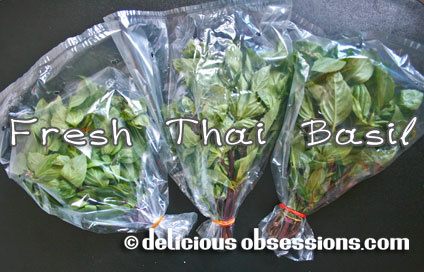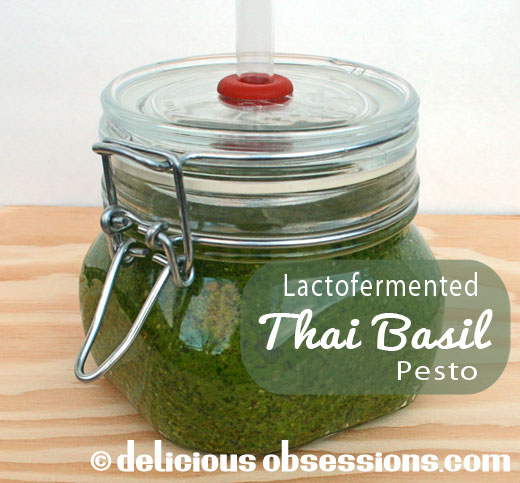FTC Disclosure: Delicious Obsessions may receive comissions from purchases made through links in this article. As an Amazon Associate I earn from qualifying purchases.Read our full terms and conditions here.
This recipe for lactofermented Thai basil “pesto” is so delicious! The first time I made this was the first time I’ve ever fermented anything other than your standard veggie and brine ferment, so I have to admit, I was a bit nervous.
I cannot take credit for the concept of fermented pesto, as I first became acquainted with it on my friend Melanie’s site, Pickle Me Too. She has a recipe for “Mexican Cilantro Pesto” that this recipe is based on. If you have never visited Pickle Me Too, I highly recommend doing so! Melanie’s site is my go-to resource when I need some fermenting inspiration. She has so many awesome recipes!
I love basil, but I really, really love Thai basil. Thai basil has a mild, sweet basil undertone, but also has an anise/pepperminty flavor. It is used often in Southeast Asian cooking, so if you have ever eaten at a Thai or Vietnamese restaurant, then you have probably had this type of basil. I love Phở (Vietnamese noodle soup) and Thai basil is a traditional garnish for the soup.
It is almost impossible to find at your normal grocery store or health food store. If you do, it is typically ridiculously expensive. I was at my local Asian market recently and was browsing their produce section to see what sorts of unique fruits and veggies they had. I stumbled across their herb section and was immediately in heaven. Their Thai basil (and regular sweet basil) is so reasonably priced at $4.00 a pound.
So, I grabbed a pound of it and brought it home, craving pesto the whole way. A pound of basil is A LOT of basil! If you can’t find Thai basil in your area, you can substitute regular sweet basil and it will be equally delicious. This Thai basil pesto is now a staple in my fridge. Both pine nuts and walnuts are delicious in it.

Fermented Thai Basil “Pesto”
I recommend the anaerobic fermenting systems from The Probiotic Jar.
Ingredients
- 12 ounces Thai basil
- 8 cloves garlic
- 1/2 cup pine nuts or walnuts (soaked and dehydrated is best)
- Juice of 1 lime
- 3 grams of sea salt
- 2-3 tbsp. 2% brine
Instructions
1. Wash the basil. If your stems aren’t too woody, you can use stems and all. Thai basil stems can sometimes be rather thick and tough, however the basil that I got for this batch has tender stems. If the stems are too tough, then you’ll need to remove the leaves from the stems.
2. Place the basil in your food processor and pulse to get the basil roughly chopped.
3. Add the garlic, pine nuts, lime juice, and sea salt and blend until everything is finely chopped and well combined.
4. In a 1/2 liter anaerobic jar, pack the pesto in tightly. Make sure you don’t fill the jar too full. I slightly overfilled the jar above.
5. Once the pest is packed in tightly, gently pour 2-3 tablespoons of 2% brine (19 grams of sea salt to 1 quart of water) over the top of the pesto. You just want enough to cover with a nice layer of brine.
6. Add your airlock, close the lid, and let ferment in a dark place for 3-4 days and then move to cold storage.
7. If you want to make it true pesto, you could stir in some Parmesan and olive oil before serving. I like to eat this with soup, on top of my eggs, and with grilled chicken or steak. I bet it would also be a delicious spread on sandwiches or used just like you would normal pesto.


10 Comments